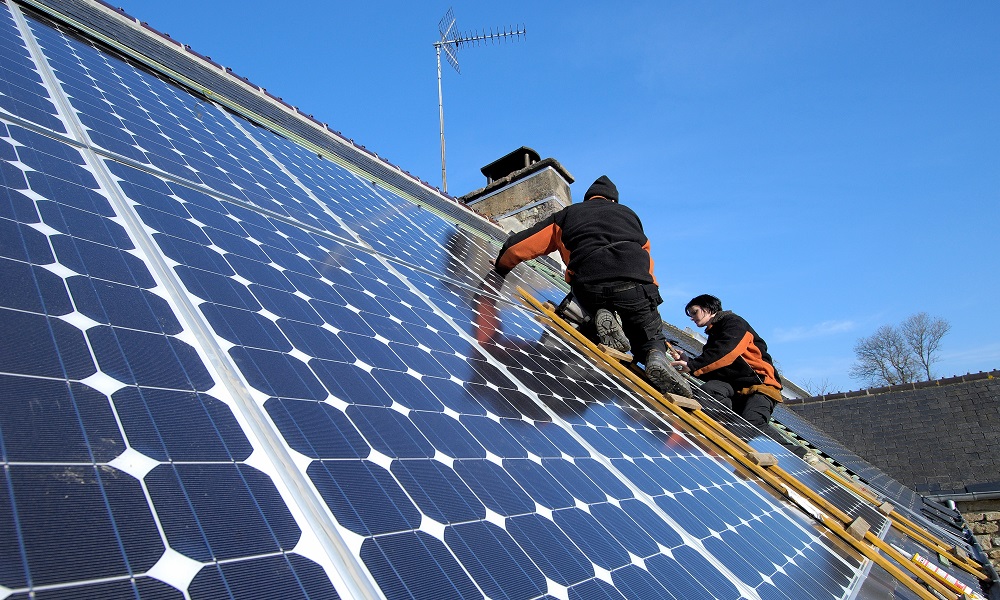Households increased capacity of private SPPs by 78% in 2022
The installed capacity of solar power plants of private households in Ukraine reached 1,385 MW as of the end of the third quarter of 2022. This is 78% more as compared to data as of the end of 2021.
“Despite the objective stagnation of industrial renewable energy development, small distributed generation continues to develop, although, naturally, not at the same pace as it did before an active phase of hostilities. For three quarters of this year, 6.5 thousand new plants having a total capacity of approximately 180 MW have been built,” said Oleksandr Martyniuk, acting Director General of the Directorate of the Electric Power Complex and Development of the Electricity Market at the Ministry of Energy, during the discussion “Renewable Energy Sources for the Population of Ukraine - Development Prospects”.
According to the Ministry of Energy, as of the end of 2021 there were 44,888 solar plants of private households operating under the “green” tariff model in Ukraine. In September 2022, their number reached 51,414.
The National Economic Strategy approved by the government envisages doubling the power generation capacity from RES by 2030 as compared to 2021 – up to 19.5 GW. To this end, it is necessary to build approximately 10 GW of new “green” generation capacities, which will cost about 10 billion US dollars. At the same time, it is expected to build household SPPs having a capacity of 3.3 GW.
However, according to Oleksandr Martyniuk, the current system of support for private energy producers at the “green” tariff is focused on gaining excess profits by them, rather than covering own consumption. The “green” tariff is currently approximately EUR 0.16-0.18, the market price is EUR 0.04. This encourages the owners of household solar power plants to maximize the output of expensive electricity to the grid in order to gain profit.
At the same time, rapid growth of the number of generating plants of private households under the current “green” tariff model leads to a sharp increase in Ukrenergo’s costs to compensate for the difference between the tariffs. Therefore, the Ministry of Energy proposes new mechanisms for stimulating the development of RES. In particular, the Ministry developed and submitted to the government the draft law “On Amendments to Some Laws of Ukraine Regarding the Improvement of the Conditions for Supporting the Electricity Production from Alternative Energy Sources by Generating Plants of Consumers”.
The document proposes to replace the fixed “green” tariff for consumers to introduce a new support model (Net Billing), which will be focused on covering own consumption and will not require additional financial costs from the state and other consumers.
The Ministry of Energy expects that this mechanism will allow consumers having installed generating plants and producing electricity from alternative energy sources to use funds received from the sale of excessive (over their own consumption) electricity produced in the next billing period. In other words, the consumer receives a monetary “deposit” for excessive energy released into the grid (at the price prevailing on the market “a day ahead” or according to contractual conditions). The electricity supplier will keep these funds on the consumer's personal account and use them to pay for the electricity consumed by him/her in subsequent periods during the calendar year in the event that the demand for electricity exceeds production.
According to the Ministry of Energy, the implementation of this draft law will ensure further development of small distributed generation of electricity from renewable energy sources by consumers without state support. This, in its turn, will contribute to the achievement of a share of 25% of electricity produced from alternative sources in 2030, as envisaged by the National Economic Strategy of Ukraine.
On his part, research director of the DiXi Group think-tank Roman Nitsovych pointed out the lack of a clear focus on distributed generation at the level of strategy and the inconsistency of some initiatives in stimulating this sector.
“On the one hand, in the beginning of July, the State Agency on Energy Efficiency and Energy Saving of Ukraine presented the concept of the introduction of Net Metering, that is, a system of netting between suppliers and consumers based on delivered and consumed kilowatt-hours. On the other hand, in October, the Ministry of Energy talked about the introduction of Net Billing, that is, netting on the basis of calculation of the cost of electricity released by the plant into the grid,” he said.
According to the expert, the Net Billing model, despite all its attractiveness, may limit the opportunities of the owner of the distributed generation facility to return the investment in its construction.
“This is a model without monetization of the accumulated positive balance of funds. Therefore, I have a question as to how much it will really stimulate the development of distributed generation at the level of households, for which the costs for RES plant are high,” added Roman Nitsovych.
On the one hand, the state’s desire to avoid manipulations, when industrial plants are built under the guise of household ones to gain attractive rates of the “green” tariff, is clear. On the other hand, it is necessary to understand the impact which such decisions will have on the sector.
For example, in Poland there was a transition from Net Metering to Net Billing this spring, along with changes in a subsidy scheme for the installation of photovoltaic systems. According to the expert, this resulted in market decline.
“As a result of such sharp change, sales of solar plants fell by 70% in the period between March and April,” the DiXi Group representative cited the statistics.
He called to offer the potential investors in the distributed generation, in addition to Net Billing, such business models that would guarantee the return of initial investments, as well as to expand the circle of potential investors at the expense of energy cooperatives, condominiums, involvement of cities, etc.









